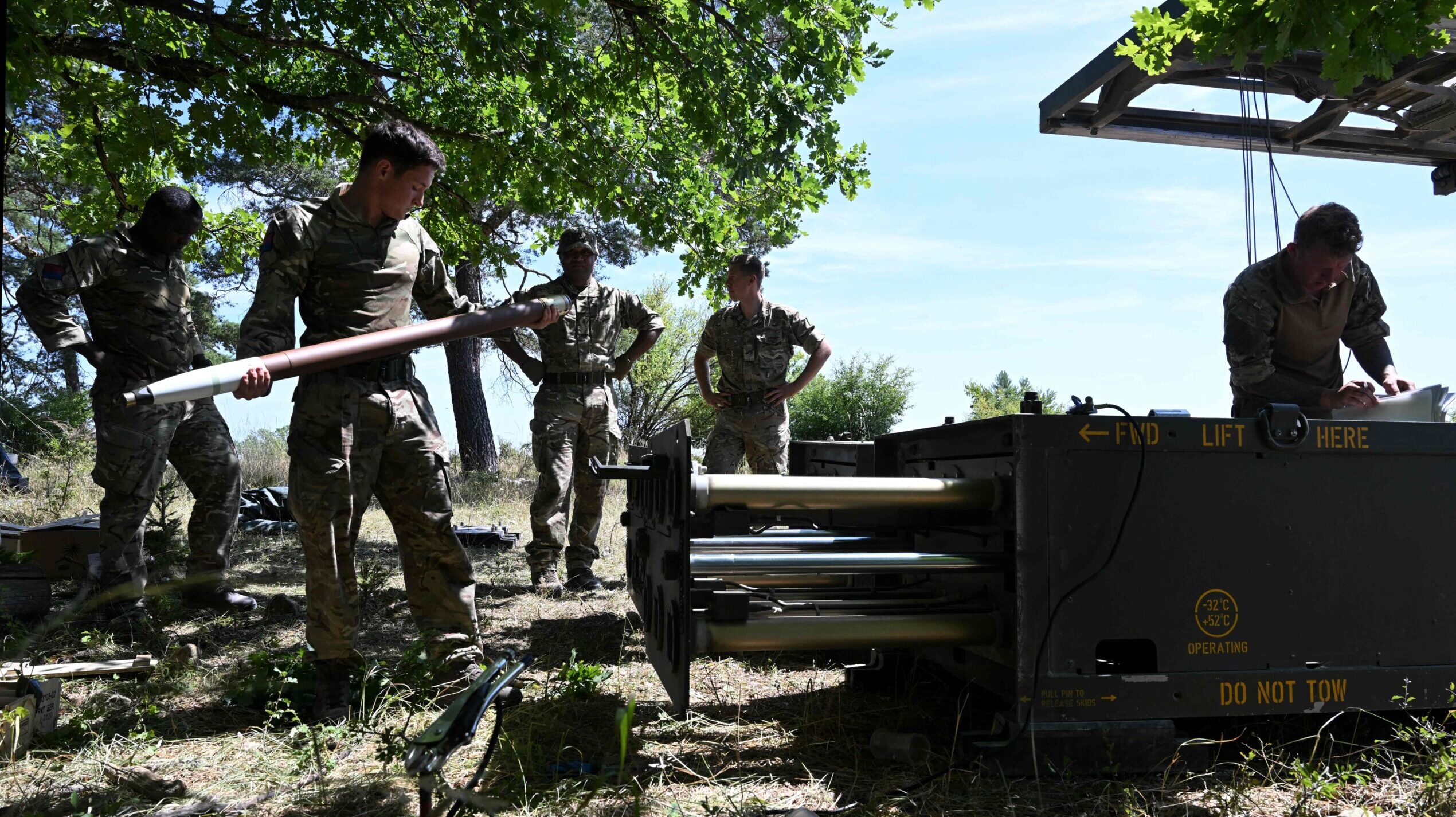
Soldiers the British Army’s 1st Royal Horse Artillery load munitions for the armored, self-propelled, Multiple Launch Rocket System (M270 MLRS) during a 2022 exercise. (CHRISTOF STACHE/AFP via Getty Images)
HELSINKI — With a number of NATO members expressing concern about munition stock and production levels, a key NATO official says now is the time for the alliance to get “smarter” about how it buys material.
Addressing delegates at Finland’s inaugural SecD-Day conference on Feb. 8, Wendy Gilmour, NATO Assistant Secretary General for Defence Investment, encouraged multinational projects and procurements across the alliance to achieve greater “economies of scale.”
Given the Ukraine conflict, “It’s more important for NATO and invitees Finland and Sweden to join and work collectively and work with industry to meet these high intensity demands,” Gilmour informed delegates at the event, organized by the Association of Finnish Defense and Aerospace in Helsinki. “When nations come together to procure capability together, it ensures interoperability and also means we get the full gambit of technology and ideas into the capability to allow us to fight together better.”
Gilmour’s comments preceded Monday comments made by NATO’s Secretary General Jens Stoltenberg at the Defence Ministers meeting in Brussels. According to Stoltenberg, NATO recently completed an “extraordinary survey” of its munitions stockpiles with plans to increase targets through the NATO Defence Planning Process.
“The war in Ukraine is consuming an enormous amount of munitions and depleting allied stockpiles. The current rate of Ukraine’s ammunition expenditure is many times higher than our current rate of production. This puts our defense industries under strain,” he said before suggesting the waiting time for large-calibre ammunition had increased from 12 to 28 months.
“Orders placed today would only be delivered two-and-a-half years later. So we need to ramp up production and invest in our production capacity,” he warned.
Stoltenberg also noted Wednesday that the US, Germany, Norway and “others” had “already” signed contracts with national industry partners to ramp up weapons production, while member states have agreed to a new ammunitions warehousing initiative. He added that NATO capability targets for weapons stockpiles are currently under review.
Ukrainian Armed Forces (UAF) operate a variety of artillery solutions, many of which have been donated by members of the NATO alliance. Examples include M270s from the UK and HIMARS from the US.
RELATED: 11 countries to give tanks to Ukraine, as Kyiv is ‘contemplating’ spring offensive: US
Also speaking at SecD-Day, Patria Group’s CEO, Esa Rautalinko, suggested the UAF were using more than 5,000 artillery rounds every day during the conflict — a figure which is more than the annual procurement of some European nations, he claimed.
Alternative figures provided to Breaking Defense by industry sources suggested this figure could actually be as high as 10,000 artillery rounds a day — an unsustainable rate for the long-haul.
“What we see is an enormous expenditure of ammunition, and we have seen that for several months, and that’s also the reason why we actually started to address that last fall,” said Stoltenberg during NATO’s Defence Ministers meeting. “We convened with meetings with the defence industry, we addressed this issue in different NATO capitals, and now we see that things are actually moving in the right direction. The production for instance, of 155mm artillery shells is now increasing, and that enables us to both bring our own stocks up, which we have depleted, but also to continue to provide support to Ukraine.”
The first of its kind conference, SecD-Day brought together senior military and political leaders as well as original equipment manufacturers from across the Nordic region who discussed the “Defense Market in the New Era.” With ascension to NATO on the table, Finland is poised to stretch as both a seller of arms and an importer of weapons.
Gilmour suggested Finland has the “opportunity to come to the table and look at a suite of multinational projects and where it makes sense, to work collectively with other nations to deliver capability.
“We have to plan and procure by design to be interoperable by developing standards together so we have an idea what has to be produced; avoid competing unduly; and cooperating to gain capability. This is interoperable by design and it’s exciting to work with Finland. You have capabilities which we have not yet integrated into this [NATO] mix,” she added.
According to Finland’s National Armaments Director, Tarja Jaakola, the Nordic country and wider European and NATO communities need to balance the requirements of today’s war with future preparations.
“We must procure materiel in a rapid manner to replenish stockpiles but we can’t forget long term requirements,” she said at the event. “We also need to cooperate more through agreements, but also purchasing. For example, demand is exceeding supply so by cooperating internationally, we ensure materiel is split between countries in an appropriate manner,” Jaakkola stated.
“The European Union [EU] benefits financially from cross-border cooperation but now it’s more of an operational requirement. EU counterparts coming to Finland are asking if we have similar requirements? Can we cooperate or do you have something similar,” she asked before explaining how Finland also needs to be able to operate independently.
Referring to increasing cooperation with its Nordic neighbors in the High North, Jaakola questioned: “Why haven’t we done more? We have similar service platforms and equipment so we can cooperate in the in-service life; find cost savings; and greater supply in the Nordic context.”
Air Force picks Anduril, General Atomics for next round of CCA work
The two vendors emerged successful from an original pool of five and are expected to carry their drone designs through a prototyping phase that will build and test aircraft.


























